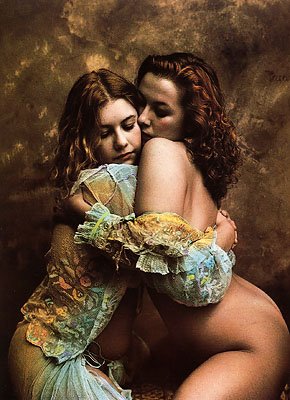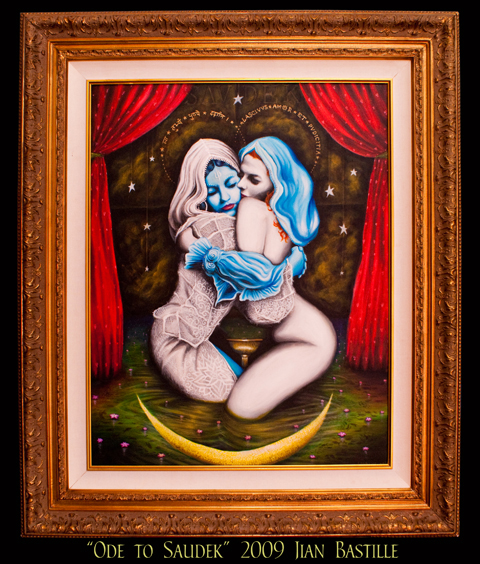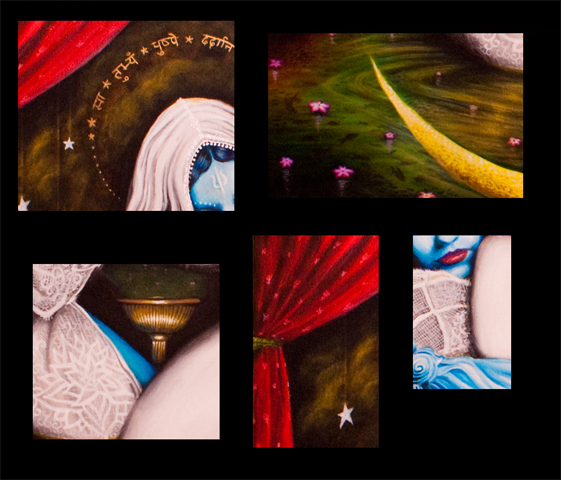“Ode to Saudek.”
One of my two all-time favourite photographs by the immeasurable Jan
Saudek, is called "Oh! Those Fabulous Brom Sisters!" and pictured
here.

Now, as an ode to the great Saudek, I give you (and him) this.
22x28 (not counting frame,) Acrylic, some silver and gold oil in details.

Details :

I could go on and on about the reason and application of the fish in the water, the flowers, the symbols in the veils, horn of isis, color schemes, thread-suspended stars, the fiery, yet muted cloud-textured wall divided like a windowpane, the curious symbols in the drape-pattern, the chalice, etc, but just take it as it is, as this is my interpretation as Saudek's work in full (internally,) all projected upon personal (some common) symbolism accommodating one single image, one image that still spellbinds me to this moment, and for many more to come.
All I will tell you is that the Sanskit says "She gives you two flowers" and the Latin says "Love (wild, wanton love) and Chastity."
Mister Saudek, my last breath may fall out of rhythm, should that original image be present near my deathbed, regardless of how many times I'd seen it from now until then. This is my most sincere thank you.
-
Edit : Explanation!
Okay, well, let's see where to begin...
As Saudek's title suggests in the original, they're sisters, as the deifications that I added, the one of the left could be Sita, Lakshmi, whichever of the Hindu Goddeses you wish, though the 'love/beauty' prominence, for those in the Hindu-know, would most likely be Lakshmi. The other is, of course, Mary, virgin or not.
The girls :
Lakshmi is usually clothed in tons of colors, but I chose plain white, a cold color, because the warmth of the entire spectrum is all about the two, if not the embrace, and to balance Mary. Mary is white not so much because of the renaissance caucasoid insistence, but for the fact that she's represented in so many statues, a white/marble grey, again, a cold color. The blue of Lakshmi's skin balances Mary's signature blue veil (which, in truth, means she's unmarried, not necessarily a virgin, hence the 'given' that she's a virgin... how many brides you know wear white? Exactly, and how many brides you know are virgins? Exactly.) Mary's skin balances Lakshmi's ensemble. Again, cold-color combinations, with warmth in embrace and colors around them. Lakshmi's detailed silver lining on the lip of her veil, and hairline is silver oil, as per the moon, Mary's is gold, as per the sun, on the lip of her veil... both micro-designs are a series of stars, Neptune symbols, and Pisces symbols, very tiny. Both veils are tapered at the hairline and adorned, suggesting female genitalia, as is the intersection of the two halo rings, forming a tapered oval! Mary's hair is red, because, of the two, Mary would by far be considered the lesser wild/more virginal of the two, and, well, aside from the association with passion and fire, we all know what redheads are like! The patterns and cloth on the girls are different textures, and the patterns are simply ornate without any specific meaning, except for the lotus representation on Lakshmi's right thigh.
Haloes :
Sanskrit "She gives you two flowers" - Latin "Love (reckless, wanton) and Chastity."
Since the deifications here are feminine, and therefore a woman/goddess suggestion, 'she' could easily be the goddess of your choice, or a simple, understandably feminine personification of beauty.
Stars : four on each side (represents 'the world' in Eastern + Western culture, such as 'four corners of the world,' nautical bearings, etc,) and one in the middle, forming nine, which, depending on your culture, means fertility, crescendo, orgasm, near-perfection, etc. They're held up by strings, stage-like, as an homage to Saudek's genius of working with what he had to, to make that little room he always shot in look like another world, vast and lush, by any means or tricks necessary.
'Saudek' (Latinized = SAVDEK) graces the top, in subltle letters.
Wall : The orange-cloud-patterned wall behind them is to balance the blue of the girls, suggest texture, and to soften the areas around the bodies, in interpretive context. It is divided by a horizontal and vertical line to suggest a windowpane weakly (Saudek almost always had a window in the background, through which you would always see something different,) and to flatten the background, to not appear as a hellish sky, but a soft, muted ember-like cotton of clouds, a personal matrixing of a patterns on a flat wall. See things in clouds? People do. Seeing clouds on a pattern on a wall? Exactly what I was going for.
Drapes : Red and rich, velvet and parting, again, like a woman's sex, patterned with alternate Neptune and Pisces symbols, soaked and color-bleeding (or is it reflection?) into the deep water.
Water : Green to balance the red, feminine, mysterious, reflective, always in motion. It ripples from the seemingly still ladies, stocked full with swarming fish (another pisces reference,) and topped with floating (feminine-leaning) flowers (purple to both balance the yellows, and, as a youth, those that grew out of my grandmother's garden, the first flowers I remember seeing, and thought them beautiful.) Originally, they were to form real constellations, but that might be a bit much. Content-wise, they also balance out the stars in the sky, similar to 'as above, so below.' The reflections of the girls in the water can either be interpreted as translucent water over them kneeling up, or simply their reflection, and are standing in deep water. I wanted to leave that up to the viewer.
Moon : The moon in phase, long-dubbed 'The Horns of Isis...' Mary is usually depicted standing over it (a slap to Eastern religions,) but here it cradles the girls, as if encouraging them to embrace, sharing the mysterious, fertile water, resting in a sort of parallel night sky.
Chalice : Long-associated with the feminine throughout history and across religious/cultural lines, both for its anatomical shape to the female frontal pelvic region, the woman's entire body like an hourglass (or a tall chalice, as well,) it being a 'recepticle,' and, even later, for the womb itself. I had half a mind to fill it with 'milk,' but that might come across as something else, despite the overwhelmingly feminine theme.
Finally, the dark corners balance out the light in the middle, as all of the colors, the full spectrum, is already represented.
That's about all I can remember putting into it.